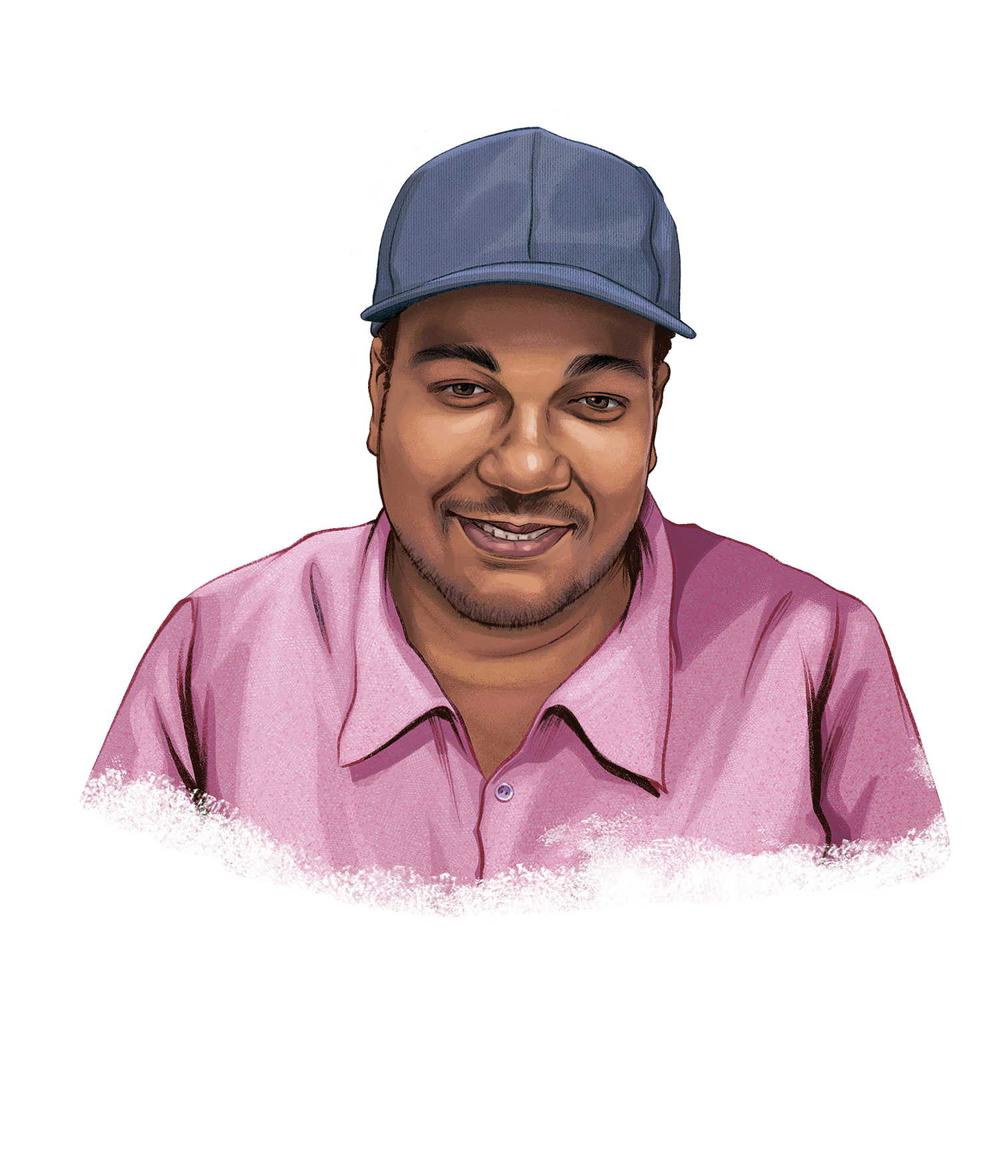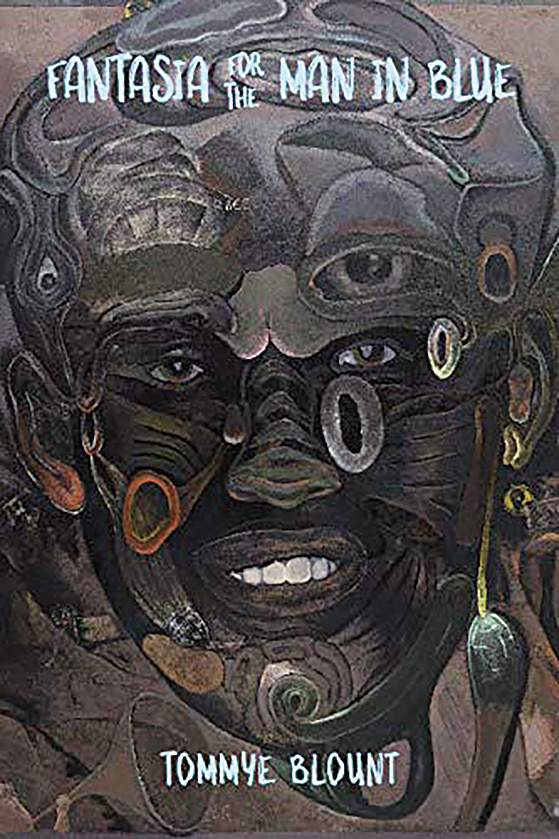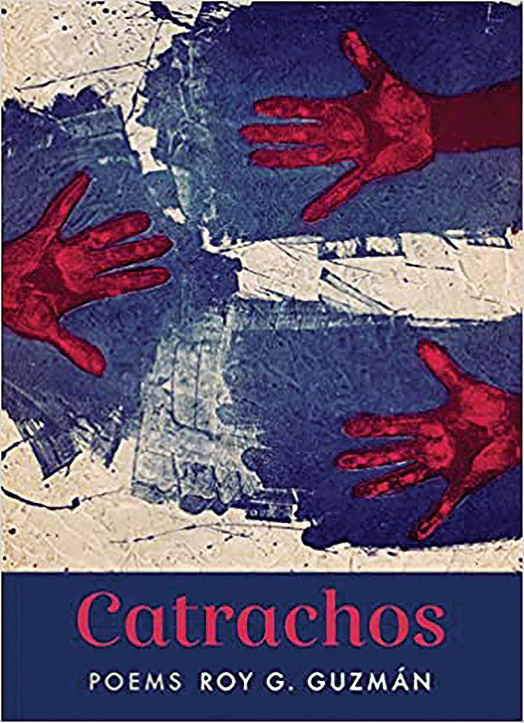Tommye Blount
Fantasia for the Man in Blue
Four Way Books
Why not take his razor
to my face
to see if I can find
beauty buried
—from “Fable of the Beast”
How it began: The backbone of the book, a quartet of poems called “Fantasia for the Man in Blue,” originated from two interactions I had with the Novi Police Department. When it happened I felt fractured. I set out writing the book to help me make sense of all those fractured parts, but it turned out to be an examination of the mutability, vastness, and dangers of beauty. When someone or something doesn’t fit a standard of beauty decided by the majority, it is deemed an intruder, and then suppressed, silenced, or killed—as we see so often now. This book is a testament of one such intruder to beauty.
Inspiration: Theater was definitely a huge influence. The book is interested in, among other things, the power play between performer and audience—each speaker appears on one sort of stage or another. Taking this a step further, Black queer adult-film actors—my men-in-blue movies—also serve as muses; each is a manipulator of the narratives around their selfhood and bodies. Lastly, Janet Jackson’s Rhythm Nation was in rotation while putting this book together. That album is vast; Jackson’s voice adopts an edge in “Rhythm Nation” only to become, toward the end of the album, airy and sultry in “Someday Is Tonight.” It is that vastness of experience that I was after with this collection.
Influences: Vievee Francis—without this brilliant poet, who has shaped so many other poets, I don’t think I would be writing poems right now. At a Detroit open mic, sometime around 2004, she beelined over to me, stared me deep into my eyes, and asked, “What are you doing with your poems?” I haven’t been the same since. For her deft manipulation of image, I return to Brigit Pegeen Kelly ever since C. Dale Young brought her work into my life. Kelly manages to build her own universe with its own physics and logic that grows from book to book—something I hope my work will do as I grow as a poet. One of the other wonders of putting this book together was getting deeper into the work of artist Peter Williams, whose “Portrait of Christopher D. Fisher, Fourth Reich Skinhead” graces the cover and inspired a poem within the book. Lastly, I have been enamored with the choreographer Bill T. Jones for quite some time. I mean: Here is a Black gay man moving his body anywhere and with anyone he wants. I urge people to watch his TED conference performance called “The Process of Becoming Infinite” on YouTube.
Writer’s block remedy: I think I’m at that impasse right now. I am knee-deep in that struggle. At the beginning of the shutdown, because part of my process has been writing at cafés, I had a rough time. Now, almost a year into all of this, I have figured out that I love Pavilion Shore Park, which sits on the shore of Walled Lake. Nature was never really my thing before, but now it’s starting to open up something for me. So I guess my solution to this impasse, as it always has been, is to change my environment.
Advice: Keep writing whether your first book gets picked up or not. Who knows what new discovery may be on its way to you in the next poem. That book will find its way eventually, but you can’t be concerned by that—onward!
Finding time to write: Before COVID, very early on Saturdays and Sundays, I would drive thirty minutes to Avalon Café and Bakery in Detroit to set up shop on a rickety table by the window. There is something magical to me about beating the sun on a Saturday or Sunday morning. Writing, when it happens, becomes an event that I look forward to each week—and, not to mention, I get a baked sweet out of the deal.
Putting the book together: In the musical A Little Night Music, a singing quintet pops in and out of the story. Each time they appear, they’re singing about their own entangled lives, and it seems to have nothing to do with what’s happening in the main story. That just isn’t true. The quintet adds tonal registers that punctuate and complicate the events happening in the plot. I’ve charged “Fantasia for the Man in Blue,” the central sequence, with this same task: The sequence must strike a note while the poems around it must find that set register. Motifs and themes introduced in the major arterial poems are complicated and/or echoed by the minor poems.
What’s next: At this point, I am not working or thinking about what’s next. This isn’t to say I am not thinking through art and the world. I have been reading so much and streaming a lot of theater online. Part of my process has always been digesting art from other disciplines, but it takes so long for the effects to be seen in my own work. I will say that for the past four years or so, I have become obsessed with fashion history and biographies. One product of that obsession can be found in my book, the poem “Framing Debra Shaw.” But who knows if that will go anywhere. I’m just focused on trying to write the next poem—writing is hard.
Age: 41.
Residence: Novi, Michigan.
Job: Account manager at a print graphics company.
Time spent writing the book: The actual sequencing of the book took a little over a year, but the oldest poems in the book are from 2008 or so.
Time spent finding a home for it: I was not looking to publish a book until the poet Martha Rhodes, my dear friend and editor, essentially said: “Look, you have a book in you, I know it, and I know your work.” How could I not be ignited by this coming from Martha Rhodes? There was a contract before I had even finished the book. This is not the norm, I know. I’m very lucky.
Recommendations for debut poetry collections from this year: Two amazing collections immediately come to mind: Nandi Comer’s Tapping Out (Northwestern University/TriQuarterly Press) and Aricka Foreman’s Salt Body Shimmer (YesYes Books). And then there is Chantal Gibson’s How She Read (Caitlin Press), a mind-bending collection that blurs the borders between visual art and language. Jubi Arriola-Headley’s original kink (Sibling Rivalry Press) just arrived, and I cannot wait to read. Special Education (Texas Review Press) by Caroline M. Mar is another debut collection I am looking forward to getting my hands on.
Fantasia for the Man in Blue by Tommye Blount
![]()
Roy G. Guzmán
Catrachos
Graywolf Press
What are we
witnesses to that implicates us insufficiently?
—from “Día de los Muertos”
How it began: For a long time I didn’t know how or where to find the words to write this book. I didn’t believe I could write a book. The book itself is an extension of many trials and errors I committed in various degrees. As someone who comes from a background where books are written by everyone else but us, I had to learn why I needed to write Catrachos. The original idea was to take stock of what I’ve been through as a queer Central American immigrant and write about those challenges. Working through and against systemic silence, I increased the scope of the book to accommodate my family’s experiences, both in the United States and Honduras. The experience of seeing through a larger lens compelled me to think even beyond the parameters of human experience; that’s where the Queerodactyl, X-Men–inspired, and more abstract poems came in. In retrospect it’s always been a passion to write against injustice that informs so much of Catrachos. I wanted to share with the world that people like me, historically and violently relegated to the margins, have histories, cultures, ambitions, and dreams for the future.
Inspiration: Besides my maternal grandfather, who passed from COVID-19 complications in 2020, I would say that I have been blessed with and challenged by a very complex mother. I was raised mostly by women, and I think my sensitivities are highly informed by how women approach the world. In that regard, feminism, femininity, womanhood, and maternal care have taught me so much about myself and given me the tools to make art. Besides my mother, some of the women that make cameos in my book include: my great-grandmother Rita, my grandmother Mamachela, my aunt, the Virgin of Suyapa, Mommie Dearest, Ana Mendieta, Phoenix and Marrow from the X-Men universe, Nora from A Doll’s House, Selena Quintanilla-Pérez, Jane Fonda, Sinéad O’Connor, Sylvia Plath, and others. To echo Kate Bush’s “This Woman’s Work,” I am in “this woman’s world.”
Influences: My words wouldn’t have the intent and music they have were it not for the three brilliant poets who blurbed my book: Eduardo C. Corral, Heid E. Erdrich, and Patricia Smith. Smith’s work has taught me how to find the punta songs I’m meant to sing. Erdrich, who I believe is a walking archive of precious knowledges, has taught me to go beneath surfaces because there is so much to find there. As for Corral, Slow Lightning (Yale University Press, 2012) has become a holy book I carry with me everywhere. I love to reread it, teach it, and seek advice from it whenever I feel alone.
Writer’s block remedy: I turn to food, music, dance, a phone call, or a long shower. I am the kind of writer who often needs to boomerang the longest way possible to get back to what originally got me to sit and write. My journaling quickly devolves into making plans, so I try to stay away from the page if the page has become hostile, brittle, or disoriented. While there are days and projects that merit either a hostile, brittle, or disoriented page, when I’ve come across a combination of any of these two or three, I make the decision to engage with other art and activities. Music re-centers me. Phone calls abroad remind me of my purpose. A long shower is an excellent way to feel more aqueous and, therefore, to feel language with less premeditation.
Advice: First of all, we need to ensure that you don’t publish a book during a pandemic. You’re going to face challenges beyond your control. Otherwise I would encourage poets trying to publish their first books to think about community. That is, what kinds of communities do you envision your book being a part of? What kinds of conversations do you wish to start or amplify? Once those questions have been tackled, poets should look for a press that champions voices like theirs. This championing needs to come in the form of transparency—I’m not a fan of this word but it’s apt enough for this discussion—and encouragement. The right press should know how to market your book, help your book connect with the appropriate readers, find opportunities so you can write your next book, and ensure that you get paid for your work. At the end of the day, when you hold a copy of your book, you should feel a sense of pride and not shame.
Finding time to write: I don’t. That’s one price I have to pay for being in a PhD program, teaching, and doing gigs around my book. I set arbitrary deadlines for myself instead. This method sometimes gets me to write drafts. If and when I return to them is a different matter altogether.
Putting the book together: I’m not exaggerating when I say the first time I got a glimpse of how my manuscript would be organized was in a dream. In the dream I was holding a copy of my book, leafing through its pages. I was blown away because part of me knew I was looking at my book and another part couldn’t believe that I had written a book. I couldn’t read the writing in the pages, but I could make out how the book was organized. The book I held in the dreamworld inspired me to think about my book in five sections, each one representing the five stars in the Honduran flag. One of the original sections, which was a hybrid essay, was eventually taken out because one thing in common with the feedback I kept receiving was that the essay needed to be its own project; I hope you may one day read it. Placing the title poem at the very beginning of the book felt like a gesture in cartography: I see it as a map legend. Eventually, the book also wanted a place to talk about the origins of the title. Because I wanted readers to be drawn into the book without a specific framework, I left a note for the end, along with a list of other notes and allusions I wanted readers to be aware of. I am forever grateful to the people, places, and things that allowed me to bring this book into this world, which turned my “Acknowledgments” section into a festival that honors all of them.
What’s next: I’ve been working on a lot of academic papers that tackle issues in Central America with different theoretical frameworks. In general, I’m working with broader canvases, broader strokes. That means you might see some short stories and experimental essays out in the world soon. There are other projects I can’t yet disclose because the tea leaves have not found their stopping points. The point is that the work is there; what I need more of is time.
Age: 35.
Residence: Minneapolis.
Job: PhD candidate in Comparative Studies in Discourse and Society at the University of Minnesota Twin Cities and an adjunct instructor at a community college.
Time spent writing the book: I would say that, while the themes and images in Catrachos have haunted me for most of my life, the first drafts of poems that made it into this volume go back to about 2012 and 2013. If there’s one thing I’m notorious for, it is working with sometimes more than forty drafts of a poem until I can hear the poem say, “Enough.” It’s not what I want; it’s what the poems want.
Time spent finding a home for it: I am lucky that, back in August of 2016, Graywolf Press had an open call for poetry manuscripts. Word on the street is that they received more than two thousand manuscripts. As soon as I heard those numbers I realized how slim my chances of them publishing Catrachos would be. But if there’s one thing I learned in 2016 and 2017, it was patience. It would take a little over a year before I heard back from Graywolf with a yes. During that time, I may have received one or two rejections and, closer to when Graywolf welcomed my book, two offers from amazing presses I truly admire. What attracted me most about Graywolf—beyond the quality of books they publish—were three things: They were local, their books had a national reach, and their editors were known for being incredibly generous. I haven’t looked back!
Recommendations for debut poetry collections from this year: 2020 has been a difficult year for debut poetry collections. I would be remiss if I didn’t mention the following collections for their necessary contributions to the literary world: George Abraham’s Birthright (Button Poetry), torrin a. greathouse’s Wound From the Mouth of a Wound (Milkweed Editions), Leila Chatti’s Deluge (Copper Canyon Press), Sumita Chakraborty’s Arrow (Alice James Books), Benjamin Garcia’s Thrown in the Throat (Milkweed Editions), and Michael Torres’s An Incomplete List of Names (Beacon Press).
Catrachos by Roy G. Guzmán
Dana Isokawa is the senior editor of Poets & Writers Magazine.













